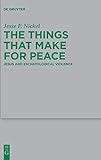The Things that Make for Peace : Jesus and Eschatological Violence / Jesse P. Nickel.
Material type: TextSeries: Beihefte zur Zeitschrift für die neutestamentliche Wissenschaft ; 244Publisher: Berlin ; Boston : De Gruyter, [2021]Copyright date: ©2021Description: 1 online resource (XVI, 309 p.)Content type:
TextSeries: Beihefte zur Zeitschrift für die neutestamentliche Wissenschaft ; 244Publisher: Berlin ; Boston : De Gruyter, [2021]Copyright date: ©2021Description: 1 online resource (XVI, 309 p.)Content type: - 9783110702415
- 9783110703870
- 9783110703771
- BS2555.6.P4 N53 2021
- online - DeGruyter
- Issued also in print.
| Item type | Current library | Call number | URL | Status | Notes | Barcode | |
|---|---|---|---|---|---|---|---|
 eBook
eBook
|
Biblioteca "Angelicum" Pont. Univ. S.Tommaso d'Aquino Nuvola online | online - DeGruyter (Browse shelf(Opens below)) | Online access | Not for loan (Accesso limitato) | Accesso per gli utenti autorizzati / Access for authorized users | (dgr)9783110703771 |
Browsing Biblioteca "Angelicum" Pont. Univ. S.Tommaso d'Aquino shelves, Shelving location: Nuvola online Close shelf browser (Hides shelf browser)
Frontmatter -- Contents -- Preface & Acknowledgements -- Chapter 1 Violence, Eschatology, and the Life and Ministry of Jesus -- Chapter 2 Violence in Second Temple Jewish Eschatological Writings -- Chapter 3 Eschatologically-Motivated Violence in Second Temple Jewish History -- Chapter 4 Jesus and Revolutionary Violence -- Chapter 5 Jesus’s Rejection of Eschatological Violence In the Synoptic Gospels -- Chapter 6 Jesus and Eschatological Conflict -- Chapter 7 Conclusion -- Bibliography -- Index of Ancient Sources -- Subject Index
restricted access online access with authorization star
http://purl.org/coar/access_right/c_16ec
This study offers fresh insight into the place of (non)violence within Jesus' ministry, by examining it in the context of the eschatologically-motivated revolutionary violence of Second Temple Judaism. The book first explores the connection between violence and eschatology in key literary and historical sources from Second Temple Judaism. The heart of the study then focuses on demonstrating the thematic centrality of Jesus’ opposition to such “eschatological violence” within the Synoptic presentations of his ministry, arguing that a proper understanding of eschatology and violence together enables appreciation of the full significance of Jesus’ consistent disassociation of revolutionary violence from his words and deeds. The book thus articulates an understanding of Jesus’ nonviolence that is firmly rooted in the historical context of Second Temple Judaism, presenting a challenge to the "seditious Jesus hypothesis"—the claim that the historical Jesus was sympathetic to revolutionary ideals. Jesus’ rejection of violence ought to be understood as an integral component of his eschatological vision, embodying and enacting his understanding of (i) how God’s kingdom would come, and (ii) what would identify those who belonged to it.
Issued also in print.
Mode of access: Internet via World Wide Web.
In English.
Description based on online resource; title from PDF title page (publisher's Web site, viewed 28. Feb 2023)









